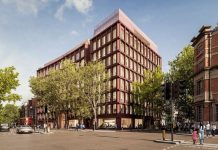Paddington saw the highest increase in office occupancy costs according to Carter Jonas, the national property consultancy, which has completed its latest analysis of London office rent, business rates and service charge occupancy costs for new and refitted Grade A space.
Michael Pain, Head of the Tenant Representation Team, Carter Jonas, said: “Paddington saw the highest increase in rent, rates and service charge occupancy costs for new Grade A space since Q2, 2017 – rising by 8.2% to £108.50 per sq ft per annum, due primarily to the new rent benchmarks that have been set by British Land’s 4 Kingdom Street development, reflecting the start of Elizabeth Line services at the end of the year.
“By contrast, Mayfair recorded the largest fall in London office occupancy costs since Q2, 2017 – declining by 5.6% to £167.00 per sq ft per annum, principally due to a decrease in rents as tenants continue to seek better value in neighbouring sub-markets.”
Other market trends highlighted by the latest report include:
- Mayfair continues to hold the record for the most expensive office location in London – notwithstanding the decline in Mayfair rents over the last 12 months
- City core vs Mayfair occupancy costs – rent, business rates and service charge occupancy costs for new Grade A space in Mayfair are now £64.50 per sq ft per annum above those for equivalent quality, prime located, mid-rise City space. The cost gap between the two sub-markets has narrowed – a year ago it was £72.50 per sq ft per annum
- Stratford has the lowest office occupancy costs of all the central and peripheral central London sub-markets – currently £70.50 per sq ft per annum – which has encouraged several government agencies to move to the area – the latest being HMRC which has taken a pre-let on 240,000 sq ft at 14 Westfield Avenue
- Rent forecast – Rents for new Grade A space in many parts of London are expected to decline by £1.50 – £2.50 per sq ft per annum over the next 12 months, reflecting continued economic uncertainty associated with Brexit
- In Paddington, Fitzrovia, Soho and Bloomsbury rents are forecast to remain static for new Grade A space for the period to Q2, 2019, reflecting both low vacancy and the imminent commencement of Elizabeth Line services, which has boosted office demand in these areas
- By the first half of 2020, rents for new and refitted Grade A space in most areas of London are forecast to plateau, underpinned by low vacancy, and a limited number of development completions – the latter being a consequence of the economic uncertainty caused by the Brexit vote
- Rent free periods – since Q2 2017 rent free periods have continued to harmonise across central London – it is now possible to secure a 22- 24 month rent free period on a 10-year lease in all the central London office sub-markets
- North City fringe rent free periods – have increased the most since Q2 2017, typically rising by up to three months to 23 months on a 10-year lease, reflecting the need for landlords operating in the Farringdon, Clerkenwell and Shoreditch areas to compete harder for tenants as the occupancy costs of Grade A space in neighbouring, more central, sub-markets decline
- Peripheral central London locations offer the longest rent-free periods – up to 27 months at Canary Wharf in Docklands and up to 26 months at Stratford on a 10-year lease

















